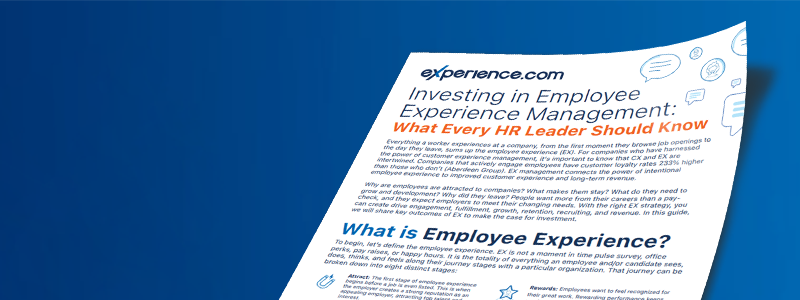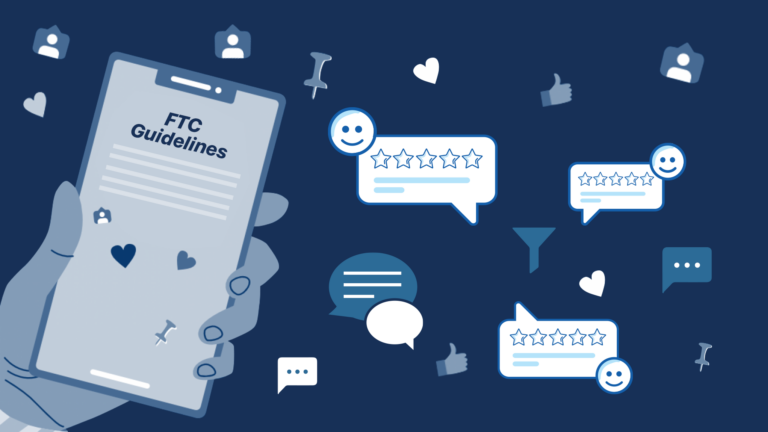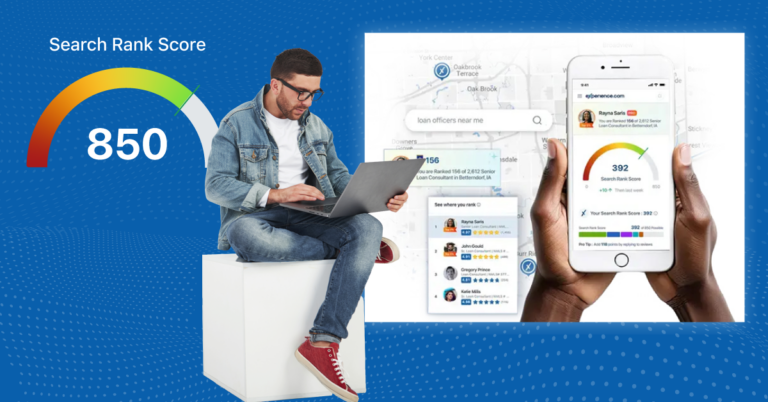Everything a worker experiences at a company, from the first moment they browse job openings to the day they leave, sums up the employee experience (EX). For companies who have harnessed the power of customer experience management, it’s important to know that CX and EX are intertwined. Companies that actively engage employees have customer loyalty rates 233% higher than those who don’t (Aberdeen Group). EX management connects the power of intentional employee experience to improved customer experience and long-term revenue.
Why are employees attracted to companies? What makes them stay? What do they need to grow and develop? Why did they leave? People want more from their careers than a paycheck, and they expect employers to meet their changing needs. With the right EX strategy, you can drive engagement, fulfillment, growth, retention, recruiting, and revenue. In this guide, we will share key outcomes of EX to make the case for investment.
What is Employee Experience?
To begin, let’s define the employee experience. EX is not a moment in time, pulse surveys, office perks, pay raises, or happy hours. It is the totality of everything an employee and/or candidate sees, does, thinks, and feels along their journey stages with a particular organization. That journey can be broken down into eight distinct stages:

Attract: The first stage of employee experience begins before a job is even listed. This is when the employer creates a strong reputation as an appealing employer, attracting top talent and interest.

Recruitment: All of the steps involved with hiring a new employee are part of the recruitment process. Things like collaborative hiring, clear criteria, and so on affect how new hires feel.

Onboarding: Next, getting new hires up to speed on team processes and expectations is another part of the employee experience. Though there’s often pressure to rush this process, it’s shown that onboarding can impact employee success. In fact, 35% of companies fail to have any formal onboarding program at all.

Development: Furthermore, as employees learn the ropes, they begin to develop within their roles. This is when they seek to expand skills, develop themselves, and gain new experiences professionally.

Rewards: Employees want to feel recognized for their great work. Rewarding performance keeps employees engaged and retains top talent.

Progression: Through ongoing conversations and reviews, teams become higher-performing through both leadership and employee support.

Retention: A strong retention strategy is key to keeping your top talent close. If they no longer feel engaged in your company’s success, they’re likely to look for new opportunities.

Exit: Finally, employees leave for a variety of reasons. Some of these are out of your control, like family changes, moving, and retirement. However, some employees leave due to dissatisfaction, and it’s important to get to the root of the cause as they depart.
Workforces are changing rapidly, shifting structures, team members, challenging recruiting, L&D, and culture-building efforts. HR leaders want to know how employees feel, and maintain communication based in their needs, role, and stage in the journey. With a strategy designed to support those efforts, HR leaders can deliver a unique level of personalized communication for potential and current employees that makes them feel heard, valued, and fulfilled at every step.
Key Benefits of Improved Employee Experience

Higher retention: When organizations keep their best-performing employees happy, they enjoy higher retention. For technical positions, the cost of employee turnover is 100% to 150% of an employee’s salary (Built In).

Better leadership: As the saying goes, people don’t quit jobs, they quit managers. 12% of people leave for more money (CareerBuilder). The majority of people who voluntarily leave their jobs do so because of poor leadership. By investing in leadership, you strengthen retention.

Stronger workforce: With strong EX, employees feel fulfilled, and in turn, are more productive. Happy, engaged employees are 12% more productive in their roles (Warwick).

More revenue: Most importantly, companies with engaged employees earn more. In fact, they pull in 2.5x more revenue compared to brands with low engagement levels (Bain & Company).

Top talent: Last but not least, when companies invest in employee experience, others take notice. With the competition between job hires more fierce than ever before, this is how you attract top talent.

Decreased costs: Strong EX management can boost online reputation, improving recruiting efforts. In fact, a strong employer brand can reduce the cost per hire by as much as 50% (LinkedIn).
By entering into a continuous feedback loop with employees, you have empowered the employee and your company to have an honest, personalized, ongoing dialogue that increases trust and sentiment. You have humanized the moments in the employee journey.
How Does Your Employee Engagement Measure Up?
In conclusion, the greater insights you have into your employee (and potential employee) sentiment, the better. Creating an intentional employee experience management program is about getting greater insights to prioritize and drive leadership action. Don’t make the assumption you know how your employees feel by asking asking them to take a single pulse survey, or not asking at all. Open a safe space for feedback, engagement surveys, and conversations about performance, training, compensation, and more with a strong experience management strategy.
Your employees are your biggest asset and determinant of company success. Are you maximizing their sentiment and feedback? Are you engaging them through each critical stage of their employee journey? Now is the time.

















